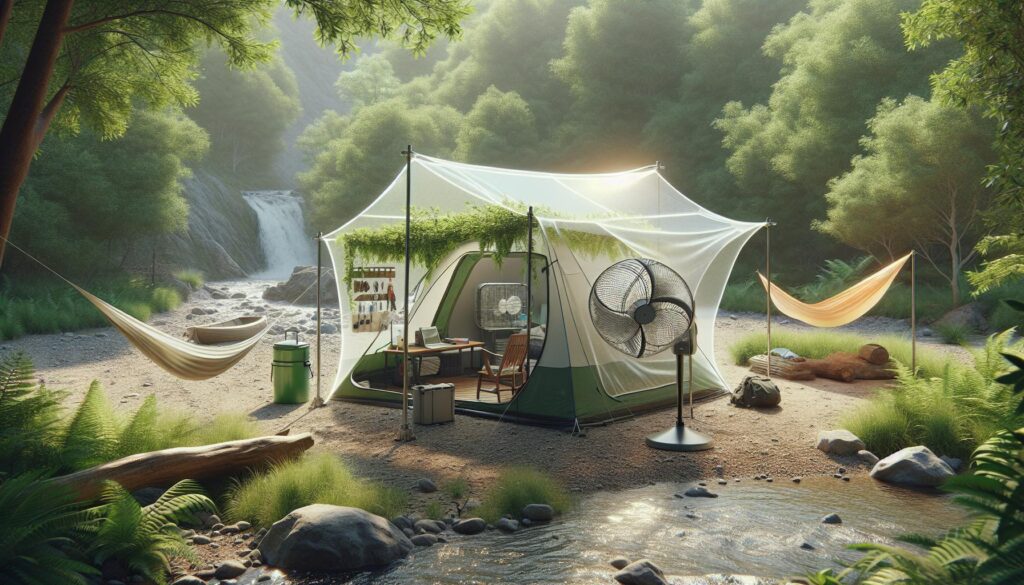Table of Contents
Staying Cool Without Power: Guide to Lowering Your Tent’s Temperature
When it’s time to go camping, staying cool in your tent without the use of electricity might sound like a tough task. Nevertheless, by incorporating natural methods such as effective placement, ventilation, and utilizing the shade, it’s entirely achievable. The beauty of camping is the connection it fosters with nature, offering an escape from modern complexities.
Sometimes, the harsh rays of the sun may transform a pleasant campsite into a stifling environment. When there’s no electricity, the task of cooling off your tent might seem challenging. But various effective techniques can help you overcome the heat and realize a more enjoyable camping experience.
Let’s discuss some proven strategies on how to keep your tent cool without electricity, including shading, enhancing airflow, and intelligent campsite selection.
Spotting the Perfect Shade
Surviving a hot weather camping experience sans electricity necessitates finding a shady campsite. Positioning your tent strategically in areas with ample shade, like under trees or surrounding structures, helps prevent direct exposure to the mid-day sun’s intensity. Keep an eye out for natural shade providers like hills, cliffs, or boulders that can offer respite from the scorching heat. Don’t forget to consider the direction of prevailing winds, which can contribute to cooling your campsite. The correct campsite can significantly improve your tent’s comfort, enabling you to keep cool throughout your trip sans electricity.
Fostering Proper Airflow Through Ventilation
In cooling a tent without power, promoting optimal airflow via proper ventilation is crucial. The first step involves selecting a tent that includes ventilation features, such as windows, vents, or mesh panels. You can enhance ventilation by opening up these areas, thus encouraging a flow of fresh air within the tent. In addition, mesh panels further increase this airflow, creating a more refreshing tent interior. To maximize your cooling strategy, aim to position your tent in an area where natural breezes are common. Optimal ventilation ensures an enjoyable camping experience, even without electricity.
Creating Your Own Oasis by Leveraging Wet Conditions
If you’re attempting to keep a tent cool without electricity, creating your own oasis with wet conditions can help significantly. Consider using a portable misting apparatus or making a DIY evaporative cooler. These gadgets capitalize on evaporation to reduce the internal tent temperature. Another tactic involves soaking towels in cold water and placing them around your neck or forehead for personal cooling. The water evaporation from the fabric offers a refreshing bodily cooling effect. Alternatively, erect a misting tent or rain fly over your own to bolster shade and bring down the overall temperature. Stay hydrated and don’t forget your sunblock while enjoying your camping expedition.
Utilizing Reflective Tarps and Emergency Blankets
Reflective tarps and emergency blankets offer a magical solution to cooling a tent without electricity. These materials can act as an additional insulation structure when installed over the tent. By fixing these tarps or blankets on the outside of your tent, with the reflective side facing outward, the sunlight is effectively reflected, thus reducing the heat permeating the tent. These reflective materials help maintain a cooler interior, enhancing your camping comfort level.
Opting for Natural Insulation Materials
Natural materials such as straw, hay, or dry leaves can be used for insulation, offering an effective way of cooling your tent without electricity. Layer these materials underneath your tent to create a cushioning barrier that blocks heat from the ground. Other useful insulating materials include cork or bamboo mats, which can be placed both under and on top of your tent to lower heat transfer. A simple yet functional technique involves creating an insulating wall with densely packed sand or rocks surrounding the tent. This barrier stabilizes the tent’s internal temperature by absorbing and dissipating heat. Using these natural resources can assure you of a cool and comfortable tent without the need for electricity.
Expanding Shade with Canopies and Tarp Extensions
Setting up a canopy or tarp extension can create additional shade and help cool your tent. Canopies can be attached to surrounding trees or erected using freestanding support structures. It’s important that the canopy provides shade to your entire tent, or even extends beyond it for maximum coverage. Opt for lightweight material canopies that are also waterproof. If desired, you can also secure a tarp extension above your tent, creating a larger shaded area. Ropes and stakes can then be used to affix the tarp to the ground or adjacent objects. Remember to regularly adjust your canopy or tarp extension to prevent direct sunlight and to optimize the cooling effect.
Smart Campsite Selection for Maximum Coolness
To cool your tent without electricity, smart campsite selection can have a significant influence. Pick an area that benefits from natural wind channels for optimal cooling airflow. Avoid setting up your tent in low-lying spots that tend to trap heat and limit air circulation. By choosing an ideal campsite, you can ensure a breeze-filled and refreshing camping experience. Camping need not be a heated affair! With the right tactics, you can enjoy cooling off even without handy electricity access.
Chill Your Tent: Mastering the Art of Beating the Heat Without Electricity
Battling the sweltering heat during a camping trip without any access to electricity? Fear not! By harnessing the power of nature and implementing a few smart strategies, you can transform your tent into a cool sanctuary. The glory and charm of camping lies in its inherent connection with nature and stepping away from the trappings of modernization.
Sure, when the relentless sun fiercely radiates heat onto your humble tent, things can begin to feel rather too toasty, transforming your temporary haven into an oven. However, being in the wilderness without electricity need not deter you; there exist various effective techniques that can help cool down your heated nest, ensuring a pleasurable camping experience.
Let’s embark on an exploratory journey together, where we’ll unlock some brilliant methods of cooling your tent without electricity. We’ll delve into natural shading, proper ventilation, and useful tips on strategic positioning near water bodies or cool natural features that will make your camping experience not only tolerable but thoroughly enjoyable.
Seeking Shade in The Right Spot
The importance of finding the perfect piece of shaded paradise for your tent cannot be overstated, especially if you’re looking to keep it cool without electricity. Strategically set up your tent under the cool shadow of trees or structures to steer clear of the sun’s harsh ray during noontime. Keep an eye out for naturally occurring shade from geography such as hills, cliffs, or large boulders, which offer respite from the sun.
Always be mindful of the direction of the prevailing wind. Doing so could also help you stay cool. Selecting an ideal spot can significantly impact the comfort level within your tent, ensuring a pleasant, cool experience throughout your camping trip. Implement these suggestions, and electricity-free camping will be a breeze!
Promoting Airflow with Appropriate Ventilation
Boosting airflow, a central player in cooling a tent without electricity, is achievable through effective ventilation. Opt for tents equipped with ample ventilation provisions, like windows, vents, and mesh panels. Opening these up allows for a cross breeze, refreshing the interior air of the tent. Mesh panels increase airflow while deterring pesky insects from entering.
Always position your tent in an area that catches the natural breeze for maximum cooling. By optimizing ventilation, you ensure a comfortable camping experience minus the luxury of electricity.
Creating a Refreshing Haven via Wet Conditions
Introducing wet conditions in and around your tent can be a fantastic way to reduce temperature without electricity. Consider using a portable misting system or try your skills at a DIY evaporative cooler, both of which help to reduce the temperature inside the tent. Soak towels or bandanas in cool water and drape them on your neck or forehead to cool yourself. Evaporation from the moist fabric provides a cooling effect.
Other options include setting up a mist tent or rainfly over your primary tent to provide the dual benefit of shade and cooling. Don’t forget to stay well-hydrated and apply sun protection to ensure a safe camping experience in hot conditions.
Reflective Tarps and Emergency Blankets: Behind the Magic
Here’s a magical solution for tents without electricity – reflective tarps and emergency blankets! Creating an extra layer over your tent with these materials provides a remarkable insulation barrier. Secure these on the outer side of your tent, with the reflective side outwards. Doing so allows these covers to effectively deflect sunlight, reducing the heat that enters the tent and maintaining a cooler internal environment.
Nature’s Gift: Cooling via Natural Materials
Nature offers plenty to keep your tent cool without electricity. Begin by layering straw, hay, or dry leaves under your tent. This insulating layer prevents heat transfer from the ground, keeping your tent’s interior pleasant. Other natural insulating alternatives include cork or bamboo mats. These materials can be placed both under and above the tent to mitigate heat transfer. Erecting an insulating wall with densely packed sand or rocks around the tent assists in temperature regulation; this barrier helps to absorb and dissipate heat.
Boosting the Shade: Canopies and Tarp Extensions
Boost your tent’s shade with canopies and tarp extensions. Secure the canopy to proximate trees or use a free-standing structure for support. A canopy extends the shaded area whenever it’s either covering or extending beyond the tent completely. Lightweight canopies ensure easy transportation and setup.
A tarp extension combined with the pre-existing tent facilitates a larger shaded area outside the tent. Rope and stakes can be used to affix the tarp to the ground or nearby structures. Always adjust the canopy or tarp extension as per the sun’s position throughout the day to evade direct sunlight. It helps to keep your tent cool, efficiently slashing the need for electricity.
The Advantage of Intelligent Campsite Selection
The right campsite can go a long way in chilling a tent without electricity. A breezy area with natural wind channels benefits smart campers looking to keep cool. Avoid pitching your tent in depressions that trap heat and cut off the breeze. Camping doesn’t have to be a sweaty, sweltering affair! The right camping tools and strategies can assist you in mastering cooling even when there’s no electricity.
Rely on Cooling Gadgets and Gear
When it comes to cooling a tent without electricity, well-selected gadgets and gear come in handy. Solar-powered or handheld fans offer excellent cooling options and are eco-friendly. Alternatively, a battery-powered air cooler or a mini air conditioner can create a path to coolness in your tent.
Pack moisture-wicking clothing and cooling towels for personal comfort. These clothing items and towels are specially designed to absorb sweat and provide a cooling effect so you can stay cool and fresh.
All in all, camping under the heatwave of summer, even without electricity, can be a fun and cool experience. By employing creative and natural techniques such as ventilating your tent properly, selecting a shady location, and employing clever cooling methods, you can assure a cool and comfortable camping experience. Let the stars above and the cool breeze around be your companions in this exciting adventure!
Mastering the Art of Keeping Your Tent Cool: Tackling the Heat Without Electricity
Wondering how to keep your tent cool without the convenience of electricity? Rest assured! With natural methods at your disposal such as proper shading, ventilation, and clever positioning, your tent won’t turn into a mobile sauna. After all, the real magic of camping lies in connecting with nature, far away from the humdrum of modern utilities.
No doubt, when the fiery sun sears down upon your tent, it can quickly transform your camping retreat into an uncomfortable makeshift sauna. Not to panic! For times when electricity isn’t an option, there are numerous effective ways to cool your tent and enhance your camping experience.
Let’s explore some proven and practical methods on how to cool a tent without electricity, focusing on techniques such as shading, ventilation, and strategic positioning near cool natural features. Soon, you’ll be ready to outsmart the heat and savor a tranquil sleep under the starry sky.
Chasing Shades: How to Choose the Right Spot
The secret to keeping your tent cool without electricity is to find the right spot. Finding a shady patch to pitch your tent under trees or structures could protect you from the sweltering mid-day sun. Nature’s shade, rendered by features like hills, cliffs, or large boulders, can provide a cozy escape from the radiant sun. Also, being aware of the prevailing wind direction can contribute to further cooling. Selecting a perfect spot can greatly increase the comfort level of your tent and ensures that you’re comfortably chilled throughout your wilderness escape, even without electricity.
Enhancing Airflow: The Importance of Ventilation
When it comes to cooling a tent without electricity, promoting significant airflow through proper ventilation is key. Make sure to pick a tent with adequate ventilation features such as windows, vents, and mesh panels. Open these options to encourage cross-ventilation, refreshing the interior atmosphere. Position your tent in a natural breeze spot for an enhanced cooling effect. Just by ensuring proper ventilation, you can promise yourself a comfortable and fulfilling camping experience that doesn’t rely on electricity.
The Art of Wet Relaxation: Creating a Cooling Oasis
If your mission is to cool a tent without electricity, explore creating a personal oasis with wet conditions. Think about employing a portable misting system or craft a DIY evaporative cooler. These instruments harness the principle of evaporation to diminish the tent’s internal temperature. Another technique involves soaking towels in chilled water and placing them across your neck or forehead. As the water evaporates from the fabric, it offers a cooling sensation on your skin. Stay hydrated and safe in the blazing wild with sun protection while you expertly diminish the effects of the hot weather.
Benefits of Reflective Tarps and Emergency Blankets
Reflective tarps and emergency blankets can work magic when it comes to cooling a tent without electricity! By using these as an extra layer above the tent, you can establish an additional insulation barrier. Fasten the reflective tarps or emergency blankets on the outside of your tent with the reflective part facing outwards. This reduces the heat entering the tent by reflecting sunlight away, giving you a cooler and more comfortable camping experience.
Brilliant Natural Insulators
Starting with a layer of straw, hay, or dry leaves under your tent can provide an effective way to introduce natural insulation. These materials serve as a buffer, reducing the heat transfer from the ground to the tent. Cork or bamboo mats offer additional good insulators that you can place both under and on top of the tent. If you’re feeling crafty, create an insulating barrier with densely packed sand or rocks around your tent. This barrier regulates the temperature inside the tent by absorbing and dissipating heat. By harnessing what Mother Nature has to offer, you can ensure a cool and comfortable camping experience that doesn’t depend on electricity.
Boosting Your Shade: Canopies and Tarp Extensions
Invest in a canopy or tarp extension to further enhance shade and cool your tent. Make sure the canopy shields your entire tent, and if possible, extends beyond it. A lightweight, waterproof canopy is easy to carry and set up. Consider extending your tarp above the tent to increase the shaded area outside. Use ropes and stakes for secure tarp installation, avoiding direct sunlight by adjusting the direction of the canopy or tarp extension. By investing in these shade-boosting techniques, you can keep your tent cool without electricity.
In Favor of Smart Campsite Selection
Picking an ideal campsite is critical in your quest to cool a tent without electricity. Choose a location that caters to natural wind channels and breezy areas. Avoid setting up your tent in low-lying areas that trap heat and limit airflow. The right campsite selection ensures that you have a cool and fresh camping experience, even without electricity.
With the right techniques, your camping adventure can become a blissfully cool retreat, even without the luxury of electricity. Embrace nature, strategize well, and enjoy a peaceful sleep amidst the wild!














